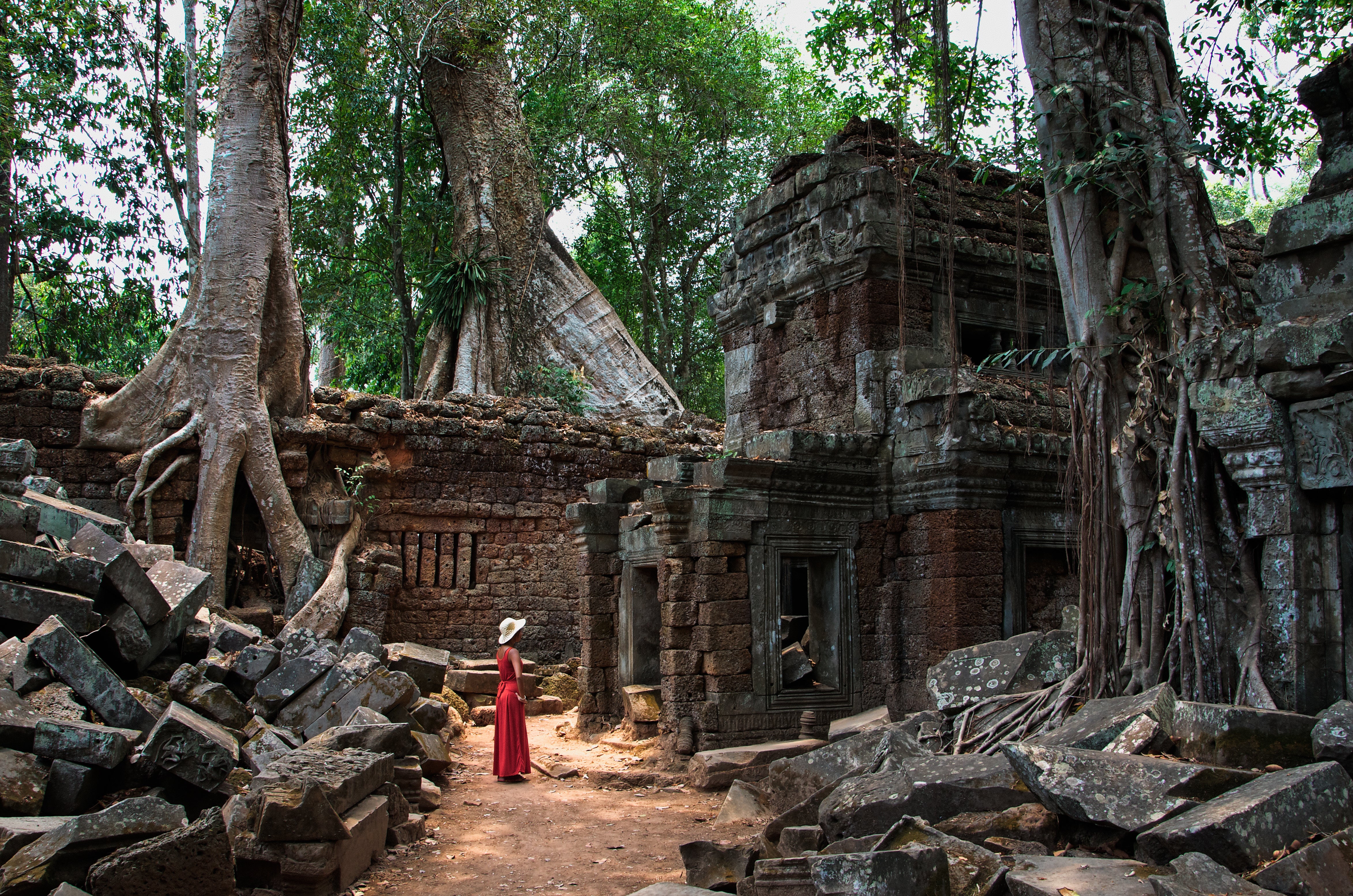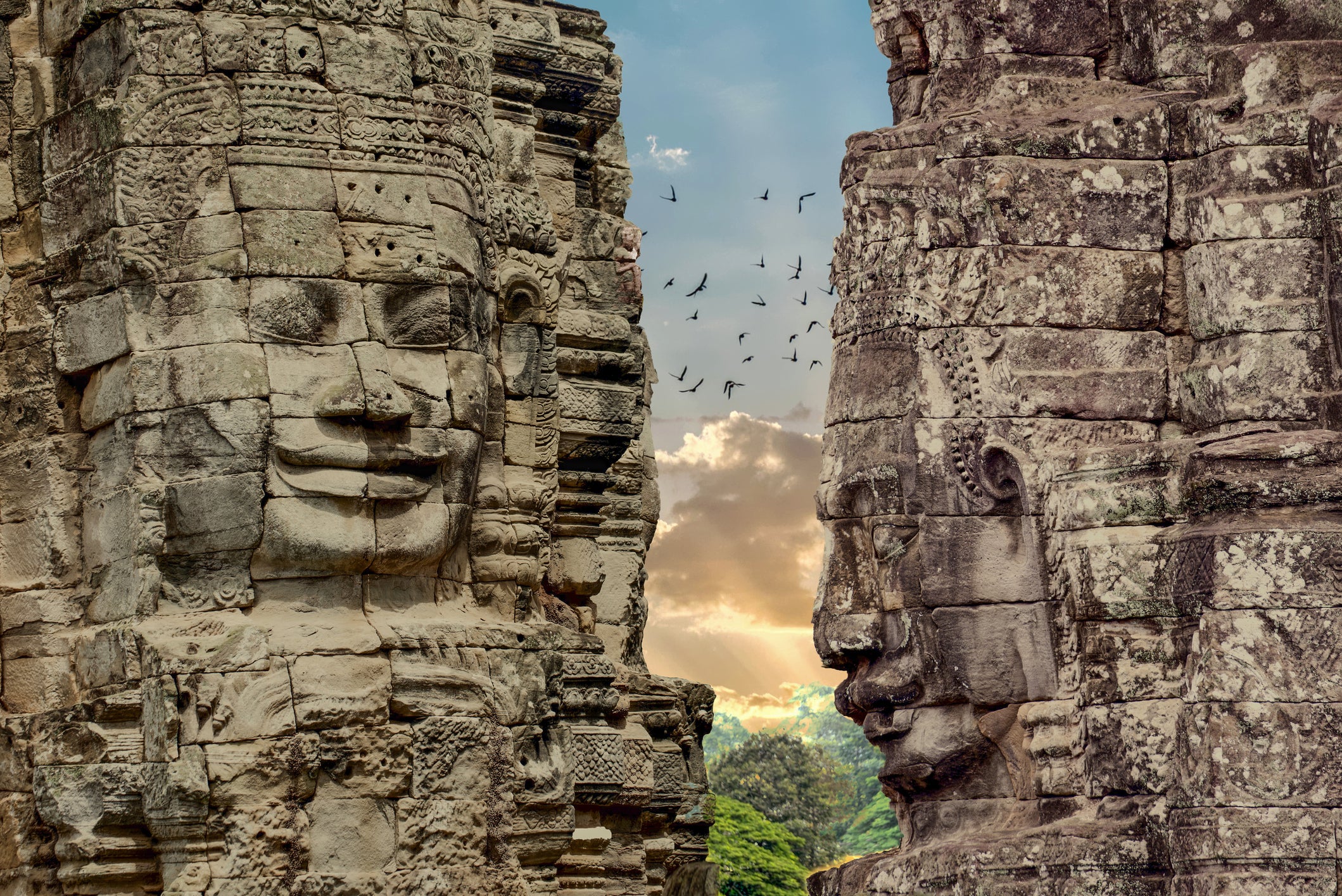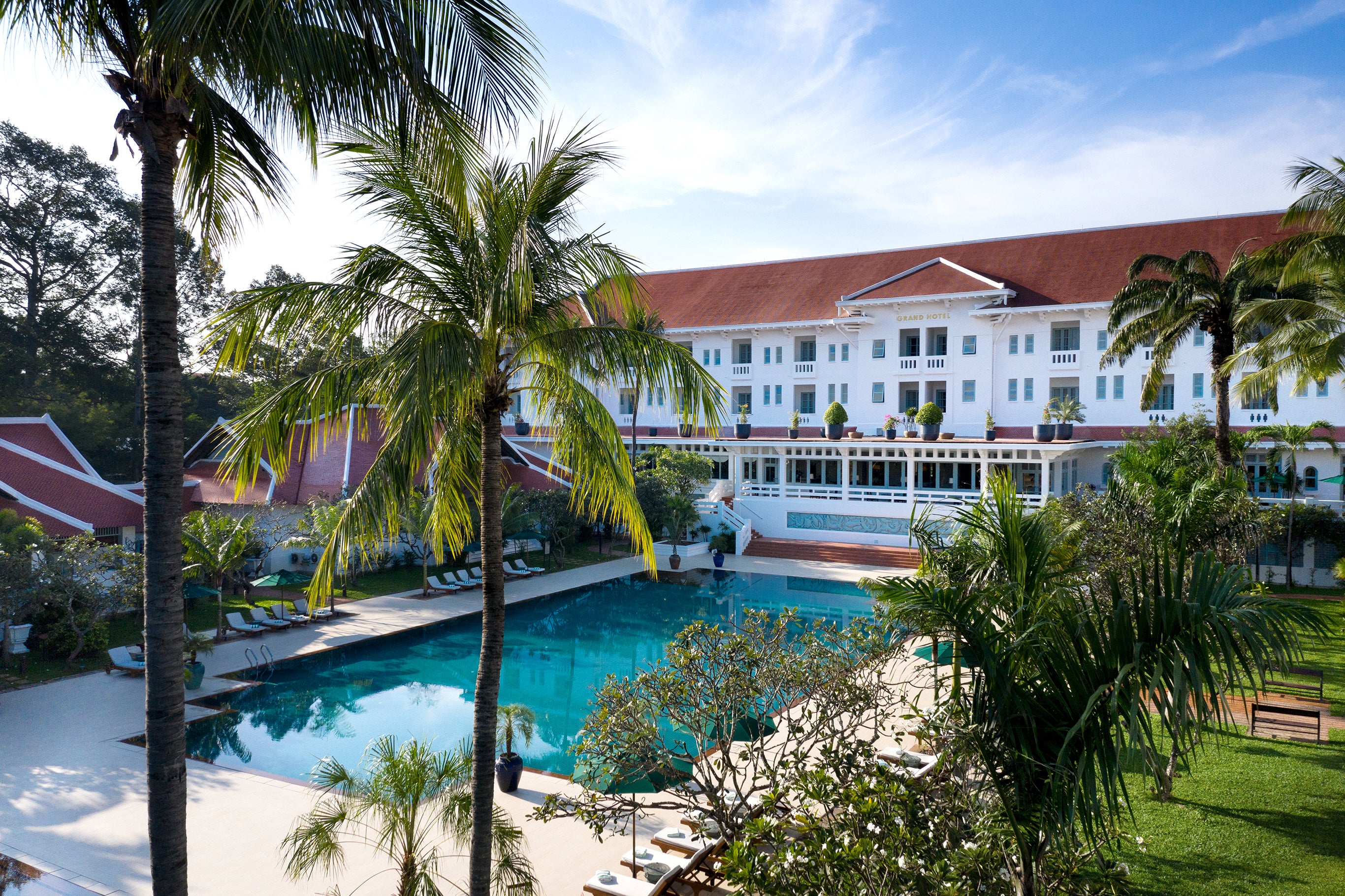Bigger than Greater Glasgow and decked in detailed bas-reliefs, the Unesco-venerated temples of Angkor in Cambodia’s second-largest city of Siem Reap are an outlier of sorts when it comes to tourist attractions: I’d be willing to bet that no one leaves this world wonder underwhelmed or disappointed. Jaws will drop, eyes will not be believed and awe will be inspired. Whatever you’re imagining, it’s bigger and better – and well deserving of its place adorning Cambodia’s national flag.
Home to the jungle-swallowed ruins of the 9th- to 15th-century capital cities of the Khmer Empire, the Angkor Archaeological Park has been on my to-visit list since I found out it existed – more so after watching 2001 film Lara Croft: Tomb Raider, which propelled annual visitor numbers from the thousands into the millions
Lately, there has been another (albeit slower) surge in tourism thanks to a new airport, relocated from its original location near Angkor (vibrations weren’t good for the ruins). New flights and increased frequency – especially from regional high-traffic destinations like Bangkok – make Siem Reap an easy addition onto an Asian itinerary, which is exactly what I did on a recent trip to Singapore, just a short two-hour flight away.
With only a few days to spare, I immediately enlisted on-the-ground travel experts Unforgettable Travel Company to make the most of my time. As with most visitors, my trip centred around a visit to Angkor, starting with Angkor Wat, the most famous of the thousands of temples that span the 400sq kilometre area.

“The locals have always known this was here, but the French came and wrote books about it and made it world famous,” says my local guide Nivath, born and raised in Siem Reap, as we walk in the predawn darkness towards the moated, 12th-century Angkor Wat. I can only just barely make out its lotus-bud-like towers against the navy clouds. Many visitors come at dawn to beat the heat and watch the sun rise, and as I wait for the sky to lighten into a watercolour of pinks and purples, we explore the gopura (entry gate) in the glow of a camera phone torch.
Nivath shows me the bas-relief of the apsara “heavenly dancers” expertly carved into the colossal bricks of sandstone, before taking me to the Buddha statues, shaded under golden parasols and draped in a saffron-hued sarong. While Angkor Wat was originally a Hindu temple dedicated to Vishnu, Cambodia is now mainly Buddhist. Some visitors may not realise Angkor is the largest religious site in the world, still home to several working monasteries.
“Many Cambodians come for religious reasons, as well as for tourism,” Nivath says. As such, there’s a requirement to dress modestly, with no bare shoulders or legs, meaning your Lara Croft skin-tight getup must be left at home. Wearing trainers or flat boots is also advisable because of the uneven ground and lots of steps (often supported with raised wooden platforms to preserve the stone).
Read more: The trailblazing female Cambodian tuk tuk group driving change in a male-dominated industry
After a dazzling sunrise, we spend over an hour examining Angkor Wat’s long decorative corridors, steep stairs and hidden nooks guarded by stone statues of Khmer lions and serpent-like naga. Next, we head to the two other major must-see temples: Ta Prohm, also known as “the Tomb Raider temple”, engulfed octopus-like in the creeping roots of the silvery sponge trees; and Bayon Temple, famed for its serene four-sided faces representing the Buddhist principle of the four sublime states of mind. While all three of these major temples are busy, they’re not overwhelmed with crowds, and it’s easy to steal away and find a peaceful spot.

One of my most potent memories is picking my way through a packed breakfast at the tumbledown Ta Nei temple, listening to the call of the Indochinese barbets and chattering green parakeets in the strangler fig trees overhead.
Another quiet site is Neak Pean. Nivath seems to know all the best spots, and if he ever wanted a break from guiding, he’d make a good art director, as he also knows all the best angles. One day at Angkor is enough to see the trio of blockbuster temples plus a few hidden gems (especially as we have a car to get around the massive complex), but given another day, I’d opt to explore by mountain bike, which is also possible.
Most hotels will arrange a packed breakfast for those heading out to Angkor at dawn, and my hotel, the historic, palm-lined grand dame Raffles Grand Hotel d’Angkor, does a magnificent job with a flask brimming with steaming coffee, pink guava juice, and flaky rambutan pastries and lotus-paste buns, all charmingly packed in a leather-trimmed white canvas backpack(Nivath’s tip: don’t carry any food in plastic bags, as it attracts the very cheeky macaque monkeys).
Read more: Seven of the best beaches in Cambodia for sandy shores, locally-caught seafood and crystal waters
Beyond Angkor, there are other temples to explore. Nivath recommends Banteay Srei or the citadel of the women, where the “stones are pink and the carvings are even more detailed.” It’s an easy stop en route to the waterfalls of Phnom Kulen, which Nivath also recommends. Another popular activity is to visit the floating villages of Tonlé Sap, the largest freshwater lake in Southeast Asia (Unforgettable Travel Company can arrange all of this).
After playing at Indiana Jones all morning, I spend the searingly hot afternoon back at my hotel. There’s nothing more divine than lying out by the palatial pool, dressed in one of Raffles’ cream striped satin dressing gowns. The building dates back to 1932, the French colonial Indochine period, and it was the first luxury hotel of its kind in the city, still housing an original wrought-iron lift in the lobby. It very much still maintains the air of a vintage reverie: iridescent dragonflies flit around the pool like jewel brooches come to life; white frangipanis blossoms scent the air; and straw-hatted staff fetch dewy G&Ts fashioned with Herbal Kulen gin, made in a nearby botanical farm that is open for visits. If you need more convincing, it’s one of Angelina Jolie‘s hotels of choice according to Nivath. There’s also a make-your-own mimosa bar at breakfast with Charles Mignon champagne if that hasn’t swung it.

Evenings at the hotel are marked by live piano melodies and cocktail-hour Grand d’Angkor slings, a riff on the Singapore sling made here with gin, pandan and galangal syrup, plus cherry brandy, lime juice and pineapple juice. Set across from the Royal Residence (home to the king when he visits), the location couldn’t be better, and it’s only a 10-minute drive to Angkor.
I spend my still-warm evenings exploring Siem Reap, which feels more like a town, set along the unmoving, mirror glass river and strung with monasteries and street food hawkers. Nivath takes me to 60 Road night market where we eat Khmer sweets like pumpkin custard and palm sugar glutinous rice balls. Some sell fried insects: glistening crickets, plump larvae and crispy tarantulas with abdomens the size of ping-pong balls. “It’s Cambodian KFC”, Nivath jokes, though he also takes the time to explain how the practice was driven by wartime poverty and famine created by the Khmer Rouge regime of the late 1970s. Visitors can learn more about this ghastly history at the Landmine Museum.
Read more: The best countries to travel to in Southeast Asia
After the night market, the food keeps coming at the partying spot of Pub Street, in the city’s Old French Quarter. Lined in balconied colonial buildings and hanging neon lanterns in primary colours, western tourists eat fried ice cream and get fish pedicures. Music pumps from every direction, while tuk tuks weave through the crowds. Nivath takes me to the Asana Old Wooden House, for hip Khmer tipples served in an original stilted wooden house dating back to the 1960s – the last traditional house in this district. Our final bite of the night is at Khmer Kitchen for amok, Cambodia’s national dish of fish coconut curry, made here with freshwater snakehead fish and best paired with an icy draft of Angkor Beer for just $1 (prices are typically listed in US dollars or Cambodian riel, as both are accepted).
.jpg)
The food is mind-bogglingly affordable but also delicious. I have the best herb-stuffed fresh spring roll of my life at the treehouse-like Chanrey Tree (stop by their spa next door, Sokkhak, for a killer massage). And I delight in the tasting menu of haute Khmer cuisine at Embassy, an all-female kitchen where the nine-course set menu costs just $54 (£42). While Cambodian food isn’t as well-known around the world as the cuisines of neighbouring Thailand or Vietnam, it emphatically deserves to be. The same can be said for the country as a whole.
How to do it
Unforgettable Travel Company offers private tours of Cambodia from £2,600 per person, with seven nights’ accommodation, daily breakfast, some additional lunches and dinners, private tours and transport throughout with English-speaking guides and private drivers, plus all entrance fees and permits.
With the opening of the new airport in October 2023, there has been an increase in new airlines and flight frequencies for direct regional flights from nearby Asian hubs like Singapore, Bangkok, Hanoi, Ho Chi Minh City, Seoul, Kuala Lumpur, and the Cambodian capital Phnom Penh. More direct regional routes are slated to arrive via IndiaGo.
There are no direct flights from the UK to Cambodia at the moment, but several airlines offer one-stop flights into Siem Reap (connecting in major Asian hubs such as Singapore, Bangkok, and Hanoi). Emirates has recently announced it will be flying to Siem Reap via Dubai from June 2025, and Etihad and Turkish Airlines are also due to start flying to the city.
Read more: The best hotels in Chiang Mai for boutique stays and luxury getaways


